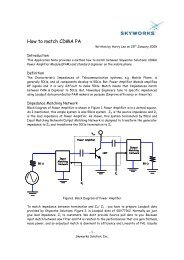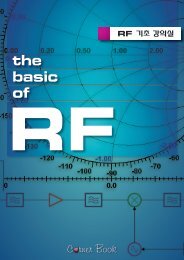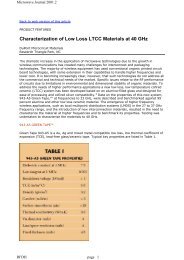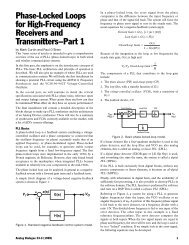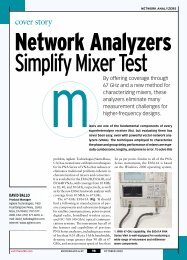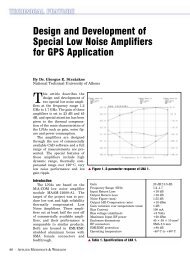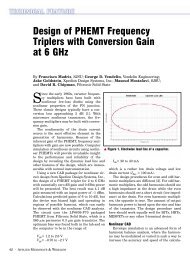Mathcad - ee217projtodonew2.mcd
Mathcad - ee217projtodonew2.mcd
Mathcad - ee217projtodonew2.mcd
Create successful ePaper yourself
Turn your PDF publications into a flip-book with our unique Google optimized e-Paper software.
Architecture Selection<br />
Amplifier Evolution<br />
The simplest versions of common emitter and common base amplifiers are shown in the<br />
following figure. They are essentially the same amplifier with the ground connection placed on<br />
the emitter and the base respectively. The distortion output power of these two amplifiers is<br />
identical, but the concept of input referred distortion and noise power is invalid, because the<br />
source impedance is zero ohms.<br />
I out<br />
I out<br />
V S<br />
V S<br />
Fig. 1: Unmatched Undegenerated Common Emitter and Common Base LNA<br />
All real amplifier have some value for source impedance. For high frequency amplifiers, this<br />
impedance is typically provided by a low loss matching network to a 50 ohm input. The value of<br />
the source impedance seen by the amplifier is usually somewhere between the optimal value for<br />
minimum noise and maximum gain. For a typical common emitter amplifier with good<br />
performance, the desired source impedance is close to 50 ohms. For a common base amplifier<br />
the desired source impedance is much smaller than 50 ohms. The large impedance difference<br />
of a common base amplifier from 50ohms requires a high-Q matching network. High Q matching<br />
networks usually have narrower bandwidths, more in-band loss, and are more sensitivity to<br />
process variations. This will degrade the performance of the common base amplifier. The<br />
distortion performance of the matched undegenerated common emitter and common base are<br />
similar.<br />
I out<br />
I out<br />
Z S<br />
V S<br />
V S<br />
Z S<br />
Fig. 2: Matched Undegenerated Common Emitter and Common Base LNA<br />
Usually the distortion and stability performance of a undegenerated amplifier is very poor, so<br />
it is desirable to place local or global feedback around the amplifier to improve it’s performance.<br />
For a bipolar amplifer, this is easily done with some inductance in the emitter of the amplifier.<br />
This inductance also helps to make the optimal source impedance for minimum noise figure<br />
closer to the conjugate match source impedance. For a common-base it is much more difficult to<br />
linearize the amplifier, because impedances in the base have little effect on the amplifier<br />
distortion. Furthermore, inductances in the base tend to destabilize the amplifier. Incidentally,<br />
inductance in the base is an common effective way to build an oscillator, such as the Colplitt’s<br />
oscillator. Our goal here is to build an amplifier, not an oscillator, so inductance in the base is<br />
undesirable.






